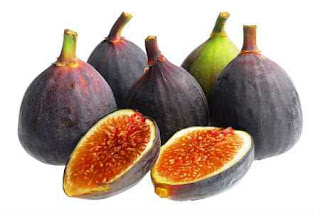 |
| Fig. 1. Fresh Figs |
Like the mulberry tree, it has a substance called latex which is extracted for industrial purposes in the related Ficus elastica. It grows to a height of 6.9–10 metres (23–33 ft) tall, with smooth grey bark.
Ficus carica is well known for its fragrant leaves that are large and lobed. The leaves are 12–25 centimetres (4.7–9.8 in) long and 10–18 centimetres (3.9–7.1 in) across, and deeply lobed with three or five lobes. Ficus carica have pyriform Sicon infructescences, the fleshy fruit fig, with inner unisexual flowers. The fruit is 3–5 centimetres (1.2–2.0 in) long, with a green skin, sometimes ripening towards purple or brown. Ficus carica has milky sap (laticifer). The sap of the fig's green parts is an irritant to human skin.
Cultivation and Uses
The Common Fig is widely known for its edible fruit throughout the Mediterranean and Middle Eastern region, Iran, Turkey, Pakistan, northern India, and also in other areas of the world with a similar climate, including Arkansas, Louisiana, California, Georgia, Oregon, Texas, South Carolina, and Washington in the United States, south-western British Columbia in Canada, Durango, Nuevo León and Coahuila in northeastern Mexico, as well as areas of Argentina, Australia, Chile, Peru, and South Africa. Two crops of figs are potentially produced each year.[4] The first or breva crop develops in the spring on last year's shoot growth. In contrast, the main fig crop develops on the current year's shoot growth and ripens in the late summer or fall. The main crop is generally superior in both quantity and quality than the breva crop. However, some cultivars produce good breva crops (e.g., Black Mission, Croisic, and Ventura).There are basically three varieties of common figs:[5] Caducous (or Smyrna) figs require pollination by the fig wasp and caprifigs to develop crops. Some cultivars are Calimyrna, Marabout, and Zidi.
Persistent (or Common) figs do not need pollination; fruit develop through parthenocarpic means. This is the variety of fig most commonly grown by home gardeners. Adriatic, Black Mission, Brown Turkey, Brunswick, and Celeste are some representative cultivars. Intermediate (or San Pedro) figs do not need pollination to set the breva crop, but do need pollination, at least in some regions, for the main crop. Examples are Lampeira, King, and San Pedro.
Figs plants are easy to propagate through several methods. Propagation using seeds is not the preferred method since vegetative methods exist that are quicker and more reliable, that is, they do not yield the inedible caprifigs. However, those desiring to can plant seeds of dried figs with moist sphagnum moss or other media in a zip lock bag and expect germination in a few weeks to several months. The tiny plants can be transplanted out little by little once the leaves open, and despite the tiny initial size can grow to 1 foot (30 cm) or more one year from planting seeds.
For propagation in the mid-summer months, air layer new growth in August (mid-summer) or insert hardened off 15–25 cm (6-10 inches) shoots into moist perlite or a sandy soil mix, keeping the cuttings shaded until new growth begins; then gradually move them into full sun. An alternative propagation method is bending over a taller branch, scratching the bark to reveal the green inner bark, then pinning the scratched area tightly to the ground. Within a few weeks, roots will develop and the branch can be clipped from the mother plant and transplanted where desired.
For spring propagation, before the tree starts growth, cut 15–25 cm (6-10 inches) shoots that have healthy buds at their ends, and set into a moist perlite and/or sandy soil mix located in the shade. Once the cuttings start to produce leaves, bury them up to the bottom leaf to give the plant a good start in the desired location. Figs can also be found in continental climate with hot summer, as far north as Hungary and Moravia, and can be harvested up to four times per year. Thousands of cultivars, most named, have been developed or come into existence as human migration brought the fig to many places outside its natural range. It has been an important food crop for thousands of years, and was also thought to be highly beneficial in the diet.
The edible fig is one of the first plants that was cultivated by humans. Nine subfossil figs of a parthenocarpic type dating to about 9400–9200 BC were found in the early Neolithic village Gilgal I (in the Jordan Valley, 13 km north of Jericho). The find predates the domestication of wheat, barley, and legumes, and may thus be the first known instance of agriculture. It is proposed that they may have been planted and cultivated intentionally, one thousand years before the next crops were domesticated (wheat and rye).[6]
Figs were also a common food source for the Romans. Cato the Elder, in his De Agri Cultura, lists several strains of figs grown at the time he wrote his handbook: the Mariscan, African, Herculanean, Saguntine, and the black Tellanian (De agri cultura, ch. 8). The fruits were used, among other things, to fatten geese for the production of a precursor of foie gras.
Figs can be eaten fresh or dried, and used in jam-making. Most commercial production is in dried or otherwise processed forms, since the ripe fruit does not transport well, and once picked does not keep well.



